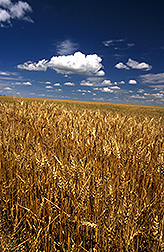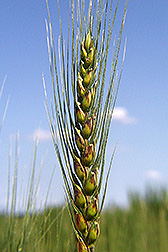A First for Fusarium:
Wheat and barley disease fungus
is fully mapped and on the Web
| A healthy wheat field outside Clay Center, Nebraska. (K11700-1) |
ARS played a pioneering role in the complete mapping of the genome of Fusarium graminearum. This is the pathogen that causes scab—the most devastating disease of wheat and barley to date. This fungus not only cuts yields of plants, it also affects their quality and produces harmful toxins. Last year, a scab epidemic crippled the wheat industry in the southeastern United States. In the 1990s, a widespread epidemic hit barley and wheat country, both here and around the world.
Farmers and scientists quickly realized that the usual methods of controlling crop disease—planting resistant crops and applying fungicides—wouldn't be enough to curb this one. So in 1997, they formed the U.S. Wheat and Barley Scab Initiative to provide seed money to encourage research on new ways to control wheat scab. ARS distributes the initiative's funds.
Corby Kistler, a geneticist at the ARS Cereal Disease Laboratory in St. Paul, Minnesota, was hired in 1999 to unravel the Fusarium genome. At that time, very little information existed about any of the pathogen's genes. Kistler, geneticist Liane Gale, and other colleagues at the St. Paul lab and elsewhere were able to sequence about 2,000 of the pathogen's 12,000 genes. That initial success was enough to attract a $1.9 million grant from the Microbial Genome Sequencing Program, administered jointly by the U.S. Department of Agriculture and the National Science Foundation.
Co-applicants for the grant included colleagues at Purdue University in West Lafayette, Indiana; Michigan State University in East Lansing; and the Broad Institute, a major genomics research center in Cambridge, Massachusetts.
Four Big Puzzles, Thousands of Small Pieces
Kistler, along with molecular geneticists Todd J. Ward and Kerry O'Donnell in the ARS Microbial Genomics and Bioprocessing Research Unit, Peoria, Illinois, sequenced parts of several hundred Fusarium genes to help map the genome. This work revealed that the fungus has only four chromosomes. O'Donnell compares each chromosome to a huge jigsaw puzzle, saying that the Broad Institute's task was to put the pieces together. They succeeded, except for some odd pieces, which Kistler and Gale have recently inserted.
"We're 99.8 percent done. It's a remarkable achievement," says Kistler. "The Broad Institute used their computer to assemble hundreds of thousands of little bits of DNA sequences into the complete Fusarium genome. Other fungi have lots of simple DNA sequences that are almost like spacers in the genome. These 'puzzle pieces' are so simple that they could fit almost anywhere. So it can be nearly impossible to find exactly where they fit," says Kistler. "Fortunately, the Fusarium genome has very few of these ambiguous, generic pieces. Almost all the pieces clearly fit in only one place."
Because of this, the sequencing is more complete than has been done for any other fungus of this type. Kistler and his colleagues are encouraged about finding a way to control scab disease using the genome information.
| Close-up of a wheat head infected with scab (Fusarium graminearum). (K11702-1) |
Two Maps Are Better Than One
"The Broad Institute's role was to take our raw genetic material and do the actual sequencing needed to assemble the genome," says Kistler. "ARS provided the genetic map—which locates the genes in relation to each other—and the Broad Institute developed the physical map, which shows the chemical makeup, or DNA sequences, that make up the chromosomes. The two maps correspond well to each other, validating the accuracy of the genome sequencing."
The genome map has been revised since its initial release. Both maps have been combined and are now on the Broad Institute's web site at www.broad.mit.edu/annotation/fungi/fusarium.
"We're releasing information as fast as possible so it can reach researchers anywhere in the world and immediately help them discover genes they can use to genetically control scab," says Kistler.
Genome work always requires collaboration, Kistler says. "It's too big a job for one person or lab to do. We enjoy this collaboration because it's an integral part of what science is all about, and we all profit from it."
At Michigan State University, associate professor Frances Trail focuses on identifying genes that enable Fusarium to form the spores that start the disease's spread each spring. At Purdue University, associate professor Jin-Rong Xu specializes in finding genes that enable the fungus to cause disease.
"Many Fusarium species can't cause disease," Kistler notes, "so we want to find out which genes make it possible for F. graminearum to cause scab. We are studying altered strains of the fungus that don't form spores or don't cause disease. That will help us find out which genes are needed to form spores and which genes cause the disease.
"We know where only half the genes that produce the toxins are. We are now using the genome sequence to find the other ones. Our overall goal is to find out how this fungus causes scab, how it produces toxins, and what environmental cues trigger scab. From there, we can devise a strategy for preventing the disease. It's a case of getting to know your enemy."—By Don Comis, Agricultural Research Service Information Staff.
This research is part of Plant, Microbial, and Insect Genetic Resources, Genomics, and Genetic Improvement (#301), Crop Protection and Quarantine (#304), and Food Safety (#108), three ARS National Programs described on the World Wide Web at www.nps.ars.usda.gov.
H. Corby Kistler is with the USDA-ARS Cereal Disease Laboratory, 1551 Lindig St., St. Paul, MN 55108; phone (612) 625-9774, fax (651) 649-5054.
Kerry O'Donnell and Todd J. Ward are in the USDA-ARS Microbial Genomics and Bioprocessing Research Unit, National Center for Agricultural Utilization Research, 1815 North University St., Peoria, IL 61604-3999; phone (309) 681-6383 [O'Donnell], (309) 681-6394 [Ward], fax (309) 681-6672.
"A First for Fusarium" was published in the February 2005 issue of Agricultural Research magazine.








